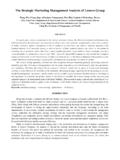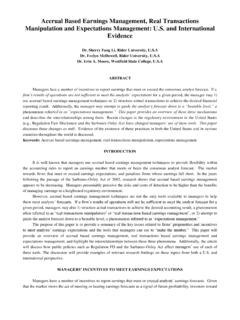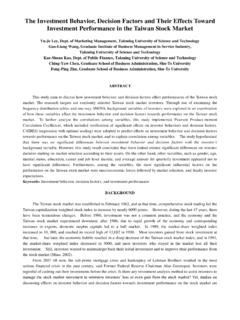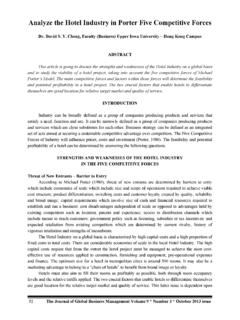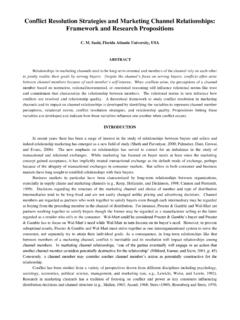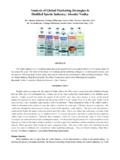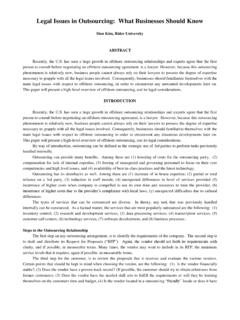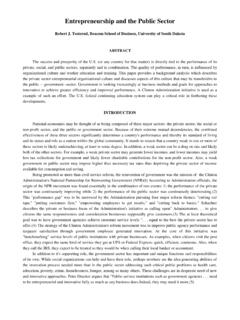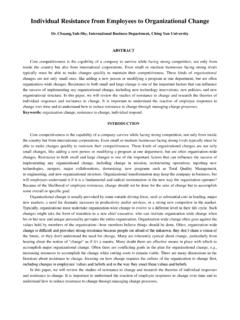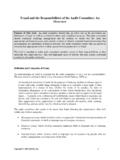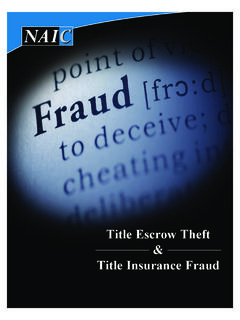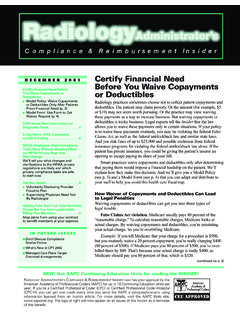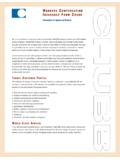Transcription of Whose Responsibility is it to Deter and Detect …
1 Whose Responsibility is it to Deter and Detect Fraud? The Role of management , the Auditor and the Fraud Examiner Marge O Reilly-Allen, CPA, PhD, Chair, Accounting Department, Rider University, USA Paul E. Zikmund, CFE, CFD, Enterprise Risk management /Fraud & Forensic Services Amper, Politzer, Mattia, LLC, Edison, NJ ABSTRACT Organizations that discover fraud, including embezzlement, asset misappropriation, and financial statement manipulation are often surprised that the incident occurred. Even more surprising to the board of directors and audit committee is that the auditors did not Detect the fraud. This paper examines the management s Responsibility to Deter fraud, the auditor and fraud examiner s Responsibility to Detect fraud, and provides recommendations for management to implement an effective anti-fraud program. INTRODUCTION Recent corporate scandals and frauds demonstrate the impact of fraud upon an organization can be devastating.
2 In addition to financial costs, corporate fraud including embezzlement, asset misappropriation, and financial statement manipulation can severely damage a company s reputation, erode shareholder confidence and even result in the collapse of major corporations. Many times, when fraud is uncovered, executives and boards of directors are surprised by the incident, and even more surprised by the fact that the auditors did not Detect the fraud sooner, or at all. Isn't that what auditors are supposed to do? Despite recently enacted regulations and professional guidance (Sarbanes-Oxley Act of 2002 and Public Company Accounting Oversight Board Auditing Standard 5, July 2007) aimed at improving fraud deterrence and detection, there is still ambiguity about the responsibilities of management , the auditor and the fraud examiner. The purpose of this paper is to examine management s responsibilities to Deter fraud, the auditor and fraud examiner s responsibilities to Detect fraud, and to provide recommendations for an effective fraud prevention program.
3 management s Responsibility to Deter Fraud In the , senior management is required to implement internal controls to prevent, Detect and Deter fraudulent financial reporting, to assess and then report on the effectiveness of those internals control on an annual basis (Section 404, Sarbanes-Oxley Act). It is important to recognize, however, that no matter how strong a system of internal control within an organization, a dishonest management has the potential to override those controls. For this reason, the tone at the top or corporate culture is a critical factor for an auditor or fraud examiner to consider. An effective system of internal control is the first step towards fraud detection but there are other steps that management can take to Deter fraud. Table 1 summarizes management s obligations to Deter fraud. Table 2 provides best practice recommendations for an effective fraud detection program.
4 Auditors Responsibility to Detect Fraud An auditor is required (Section 404 of Sarbanes-Oxley Act) to evaluate a clients antifraud programs and internal control over financial reporting and to issue an opinion on management s assessment of internal control. Auditors are also required (Statement of Auditing Standard No. 99) to plan the audit to provide reasonable assurance that financial statements are free of material fraud. Planning includes adopting an attitude of professional skepticism towards a client, conducting brainstorming sessions to assess the risk of material fraud and how it could be concealed, conducting an assessment of a client s overall antifraud programs and looking for red flags that may indicate fraud. The Public Company Accounting Oversight Board s Auditing Standard 5 (2007) reinforces this guidance. Auditor s Role as an Investigator At what point does the external auditor become an investigator?
5 What should management expect if this occurs? First, it is important for management to understand that no clear guidance exists to specifically state what steps an auditor must follow when suspicious of fraud. It is a matter of the auditor using his or her professional judgment and deciding when to explore, dig deeper and review more data. It is at this point, the auditor decides whether to become an investigator. In the event of an audit failure, (when an audit fails to uncover an existing fraud) the inevitable question is where were the auditors and how did this happen? There is no shortage of court cases in which audit firms were found at fault for failing to Detect or disclose material frauds. Table 3 lists the primary reason auditors fail to Detect fraud. Simply being aware of and addressing these reasons can help management and auditors avoid future audit failures.
6 Auditor versus Fraud Examiner Both an auditor and fraud examiner share common attributes but their roles differ significantly and it is important to understand the differences. Many companies will call in a fraud examiner to conduct an investigation once fraud is suspected, but the external auditor is the initial investigator when an indicator of potential fraud (referred to as a red flag) is identified. Table 4 summarizes the key differences in roles between the auditor and fraud examiner. To illustrate, consider this scenario: during the routine end of year audit at a publicly traded company, an external auditor reviewed various accrual accounts as part of the audit. He uncovered approximately ten manual entries made after the quarter close which lacked sufficient supporting documentation and significantly reduced the reserve balance for each account. The auditor reviewed the entries in the system and found the same explanation for each reduction reduce accrual by $1,500,000 per corporate controller.
7 The total amount of reductions to the accrued expenses exceeded $15,000,000 and was material to the financial statements of the company. The auditor brought this information to the attention of his audit manager who advised him to discuss the entries with the corporate controller who is a respected member of management . The controller provided verbal support for each entry and did not inform senior management of the inquiry. Since the auditor had no reason to disbelieve the controller, he cited the lack of supporting documentation as an audit finding and completed the report. Six months later senior management accidentally discovered that the controller was adjusting various accrual accounts to manipulate earnings. A fraud examiner was brought in to document the extent of the fraud. Based on the findings of the fraud examination, the controller was terminated and the company faces investigation by the Securities Exchange Commission (SEC).
8 The company s Board of Directors and Audit Committee were caught off-guard by the fraud. What went wrong in this audit? How could the problem be avoided? The auditor was on an engagement to issue an opinion on the financial statements. The auditor did exercise some level of professional skepticism by bringing the red flag items to his audit manager. He failed, however, to maintain an appropriate level of skepticism, by not recognizing that the unauthorized checks indicated a material fraud. This may have been due to his lack of experience of failure to adequately brainstorm for potential fraud schemes. Either of which could have been avoided by better monitoring of the inexperienced staff auditor and a more thorough brainstorming session while planning the audit. management , on the other hand, should have had a more effective system of internal control. A formal risk assessment plan should Detect a weakness such as this.
9 Moving Forward: Fraud Detection Expectation Gap and Current Developments In its November 2006 report, Global Capital Markets & the Global Economy, CEOs of the six largest audit firms (BDO International, Deloitte, Ernst and Young, Grant Thornton, KPMG, and PricewaterhouseCoopers) stated there is a significant expectation gap between what various stakeholders believe auditors do or should do in detecting fraud and what auditors are capable of doing at prices companies or investors are willing to pay. The CEO s point out that fraud detection methods recommended under SAS 99 are not foolproof and that auditors are often restricted in their methods to Detect red flags for fraud. As an example, the CEOs cite the limitation of using indirect means such as reviews of anomalies and interviews not conducted under oath to ascertain if the possibility of fraud exists during the audit. Among its recommendations directed at narrowing the expectation gap, the CEO s proposed a constructive dialogue among investors, other company stakeholders, policy makers and accounting professionals.
10 Some potential steps for consideration include: subject all public companies to a forensic audit on a regular or random basis, let shareholders decide on the intensity of the forensic audits or let the audit committee decide on the level of the forensic audit. The CEOs also suggest penalizing those directly implicated for failing to uncover material fraud rather than on entire auditing firms that employ them. In contrast to the CEOs viewpoint, the regulators at the PCAOB believe that auditors should do more to Detect fraud. In January 2007, the PCAOB released a report, Observations on Auditors Implementation of PCAOB Standards Relating to Auditors Responsibilities with Respect to Fraud, based on observations made during their inspections of audit work performed by registered public accounting firms. Some key areas of concern to the PCAOB include: auditors overall approach to the detection of financial fraud, required brainstorming sessions and fraud-related inquiries, auditors response to fraud risk factors, financial statement misstatements, and fraud associated with management override of controls The PCAOB recommends that auditors improve their fraud assessment techniques and better document their efforts to Detect material fraud.
